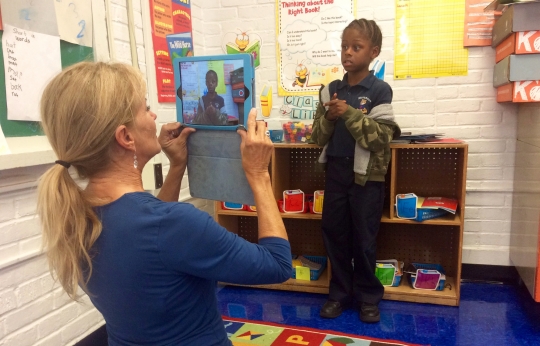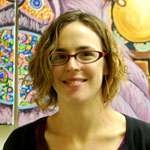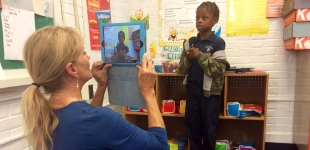
Louisiana Teacher recording a student's performance during an A4L Unit

An Interview with Jenny James
Director of Education and Programs, Young Audiences of Louisiana, implementing a Professional Development for Arts Educators (PDAE) grant from the U.S. Department of Education to train teachers in arts-integrated instruction within five Title 1 Jefferson Parish schools. Approximately 50 second-, third-, and fourth-grade teachers received full-day training sessions and in-school support based on a co-teaching model that brings teaching artists into the classroom.
Back in the old days, teachers who wanted to present Arts for Learning (A4L) had to have their CD ready and come equipped with enlarged, printed, and laminated lessons to post on the walls. That was the level of technology in the classroom, says Jenny James, who joined Young Audiences in 2008 and was part of the initial program rollout.
Now Jenny is involved in a PDAE grant project aimed at providing teachers in five Title 1 schools in Jefferson Parish with tools, strategies, and instructional methods for aligning arts-integrated lessons with educational standards. At the heart of the project is a digital platform accessed through tablet technology as a way to increase teacher effectiveness and enhance student learning through the arts.
The first step was bringing nearly 50 teachers together, in January 2015, for a Teacher Professional Development Institute. This was followed in the spring with a second day of professional development in which teachers received iPads and training on how to use them in conjunction with presenting A4L units.
“The Arts4Learning.org website works very well on the iPad, bringing a wealth of information to your fingertips,” Jenny says. “The ability to project images, access sound files and movie clips, and retrieve additional examples for lessons has been a great help to our teachers. The technology is a time-saver and tremendously useful because all the work that has been done is accessible on the website.”
The PDAE grant also provided the opportunity to substantially increase the presence of teaching artists in the classroom, aligning with the A4L co-teaching model. Not only do teaching artists bring expertise in music or dance or painting, they also helped classroom teachers become more comfortable with the digital platform. “For classroom teachers who weren’t as familiar with iPad technology, teaching artists were able to support them along the way by modeling how and when to use it during that first semester,” Jenny says. “The teaching artist would use the iPad to project images and play clips, and so even teachers who might have been reluctant were able to see the benefits of using the technology.”
Teaching artists and classroom teachers work together to present 10 to 12 lessons, with a few assignments in between for the classroom teacher to extend the learning. “This has been tremendously helpful for teachers who are new to arts integration. Not only is there a prewritten curriculum that has been vetted and proven over a decade, but a professional artist is in the classroom to support them, model the strategies and technology, observe and provide feedback, and then pass everything off at a comfortable rate so the teacher can take ownership of presenting these lessons,” Jenny says.
This co-teaching model has boosted both the success of A4L and teacher buy-in. “While teachers had heard about the benefits of arts integration and believed it theoretically, they found it daunting to be sent off after a one-day workshop with a massive curriculum and told to just do it. But when they knew an expert would be coming into their classroom on a regular basis to support them, it made it easier to dive in.”
Now teachers are seeing significant results, with gains in literacy, interpersonal skills, and engagement. Jenny reports hearing stories of English-language learners who never spoke in class now raising their hands to answer questions. Another teacher said, “Of course we see the benefits. Our children are excited about learning, and anytime you have excitement about learning, then learning is going to take place.”
Last year, Jenny attended a final presentation of students’ personal narratives. One boy read his aloud, addressing the topic of writing about a time the student lost someone or something. During the question-and-answer session afterward, the boy who acted tough in school and was not a strong academic achiever admitted he didn’t like writing about loss. When asked why, he replied, “I really don’t like to get all emotional and stuff at school, but I’m really glad I did it because I learned that it helps me to talk about and write about these things.” Remembering that moment still makes Jenny teary.
What makes Jenny proud is seeing how beneficial the arts-integrated strategies and techniques are in practice. “From the beginning, A4L provided a wonderful example of solid arts-integrated lessons for teachers who are starting down this path,” she says. “The program has become more adaptable to teachers’ needs over the years, and I’d like to see this continue so teachers can take the next steps to tie these tools and strategies into other areas of the curriculum.”


